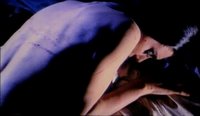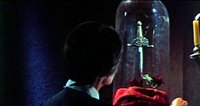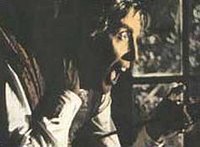
This is undeniable-proof that Mario Bava was one of the best horror-directors of all time. The maestro's use of color and unnatural-lighting is stellar, and unique. There are few films that convey desire so deeply, so-yearningly, but also depict repulsion just as well; and aren't the two inextricably-entwined in horror? It is perhaps the best Gothic horror film of the 1960s, bar-none, and that includes some of Hammer's finest. In-fact, you can see that in Bava's, Hammer's and Roger Corman's 'Gothic' films, there is a dialog going on. They copied-each other, but few would be so daring as Bava, as this is the best S&M horror-film, and the sexiest too.
Dahlia Lavi couldn't be more desirable in this, and the S&M depictions are pretty racy, even by the standards of today. In 1963, the culture couldn't withstand-it. For this reason, it was radically-cut in most regions-of-distribution (except Germany!). 'Black Sunday/Mask of Satan' (1960) may have been the 'Citizen Kane' of horror, but this is Bava's 'Tales of Hoffmann' (1951), and all these films should be seen by serious horror fans. Corman, AIP and Hammer had blood, brains, bulging-boobs and cleavage, but not this!
It is probably the most underrated film I have ever seen. A film like The Whip and the Body has to be watched repeatedly to truly appreciate, and it gives-up secrets with each viewing. What has always been a shoddy dubbing job has marred this film's reputation and relegated it to-the-margins of the horror genre. The Whip and the Body is the essence of what truly makes-up horror, especially Gothic horror, and it is psychosexual tension. If you cannot appreciate such literary concerns, or the eternal-issues involving the human condition, you aren't going to enjoy it, because it is a pretty literary film. It is poetic and strongly erotic. It is also decidedly not 'PC', but who cares anymore about that? Art never is, nor should it be, 'acceptable.' It simply is.
essence of what truly makes-up horror, especially Gothic horror, and it is psychosexual tension. If you cannot appreciate such literary concerns, or the eternal-issues involving the human condition, you aren't going to enjoy it, because it is a pretty literary film. It is poetic and strongly erotic. It is also decidedly not 'PC', but who cares anymore about that? Art never is, nor should it be, 'acceptable.' It simply is.
Outside of Hitchcock, psychological horror doesn't get much better than this masterpiece. It is a ghost story, and so much more. It is a study of sexual obsession, and the demons that haunt all relationships. Who has not been haunted by a lover from one's past? If you haven't, you are missing-something important in the human condition, so go out and find it. The archetype of the 'demon lover' is in full-bloom in this masterpiece, and it is titillating and emotionally-powerful for it. It should also be said the film has a few similarities to Ricardo Freda's classic, 'The Ghost' (1963), which is likely due to the era it was made in, and the fact that Bava was frequen tly Freda's assistant director. Guilt plays its part in the films of both directors, usually manifesting as an apparition. Catholic guilt? This is likely, but neither Bava or Freda can be typed so easily, they were nonconformists in their stylizations, with Bava even showing a connection with Slavic-literature in the works of Gogol and Tolstoy. He borrowed from a lot of literary sources, including Lovecraft, making it into something that was his own. The director was also known for his belief in Italian folk superstitions, and he drew from Italy's folklore and Roman mythology.
tly Freda's assistant director. Guilt plays its part in the films of both directors, usually manifesting as an apparition. Catholic guilt? This is likely, but neither Bava or Freda can be typed so easily, they were nonconformists in their stylizations, with Bava even showing a connection with Slavic-literature in the works of Gogol and Tolstoy. He borrowed from a lot of literary sources, including Lovecraft, making it into something that was his own. The director was also known for his belief in Italian folk superstitions, and he drew from Italy's folklore and Roman mythology.
 As far as I can tell, much of the 'color-coding' in this film for given characters was relatively-new when Bava attempted-it. Powell & Pressberg's 'Tales of Hoffman' is the closest I can recall with this style conveying horror so effectively. Lee's-character (Kurt Menliff) is portrayed in the cobalt-hues of blue ever to grace a Technicolor film, suggesting the character spectral-nature. Other times, Lee is lit with a green light on his face giving him the appearance o Osiris. I'd say some aspects of the film resemble the myth of the resurrection of Osiris by Isis (through sexuality). Lee is the dying god, Nevenka his Astarte or Isis. Scenes of passion with Dahlia Lavi are decidedly red-in-hue, while when the apparition of 'Kurt' gives us scenes that are green or blue. One scene has Lavi walking down a hallway while each side of her face keeps changing colors as her emotions change. The whole approach is a kind of expressionism of color, the hues conveying the internal states of the characters. The Technicolor process made colors so deep!
As far as I can tell, much of the 'color-coding' in this film for given characters was relatively-new when Bava attempted-it. Powell & Pressberg's 'Tales of Hoffman' is the closest I can recall with this style conveying horror so effectively. Lee's-character (Kurt Menliff) is portrayed in the cobalt-hues of blue ever to grace a Technicolor film, suggesting the character spectral-nature. Other times, Lee is lit with a green light on his face giving him the appearance o Osiris. I'd say some aspects of the film resemble the myth of the resurrection of Osiris by Isis (through sexuality). Lee is the dying god, Nevenka his Astarte or Isis. Scenes of passion with Dahlia Lavi are decidedly red-in-hue, while when the apparition of 'Kurt' gives us scenes that are green or blue. One scene has Lavi walking down a hallway while each side of her face keeps changing colors as her emotions change. The whole approach is a kind of expressionism of color, the hues conveying the internal states of the characters. The Technicolor process made colors so deep!
This is film-as-artifice, and we should never forget this while viewing the works of a director like Bava, he reveled in this artificiality. This helped him emphasize the thematic visually, rather than through dialog and a linear narrative. Yes, it's supposed to look 'fake', it's a film reality, like in a Tarantino film. This movie has suffered-enough! The storyline isn't very difficult to follow, it's just the poor dubbing by the Italian production company. When a film is this low-budget (for 1963), it's usually post-production that suffers, and it does here. The owners of this property should record Mr. Lee's dialog for this film-- he has offered, after-all, so why-not? It's insane to think the producers of a film with Christopher Lee would not see fit to use his actual voice, because he is an actor who was known for it (and still is).
Tarantino film. This movie has suffered-enough! The storyline isn't very difficult to follow, it's just the poor dubbing by the Italian production company. When a film is this low-budget (for 1963), it's usually post-production that suffers, and it does here. The owners of this property should record Mr. Lee's dialog for this film-- he has offered, after-all, so why-not? It's insane to think the producers of a film with Christopher Lee would not see fit to use his actual voice, because he is an actor who was known for it (and still is).
Dahlia Lavi couldn't be more desirable in this, and the S&M depictions are pretty racy, even by the standards of today. In 1963, the culture couldn't withstand-it. For this reason, it was radically-cut in most regions-of-distribution (except Germany!). 'Black Sunday/Mask of Satan' (1960) may have been the 'Citizen Kane' of horror, but this is Bava's 'Tales of Hoffmann' (1951), and all these films should be seen by serious horror fans. Corman, AIP and Hammer had blood, brains, bulging-boobs and cleavage, but not this!
It is probably the most underrated film I have ever seen. A film like The Whip and the Body has to be watched repeatedly to truly appreciate, and it gives-up secrets with each viewing. What has always been a shoddy dubbing job has marred this film's reputation and relegated it to-the-margins of the horror genre. The Whip and the Body is the
 essence of what truly makes-up horror, especially Gothic horror, and it is psychosexual tension. If you cannot appreciate such literary concerns, or the eternal-issues involving the human condition, you aren't going to enjoy it, because it is a pretty literary film. It is poetic and strongly erotic. It is also decidedly not 'PC', but who cares anymore about that? Art never is, nor should it be, 'acceptable.' It simply is.
essence of what truly makes-up horror, especially Gothic horror, and it is psychosexual tension. If you cannot appreciate such literary concerns, or the eternal-issues involving the human condition, you aren't going to enjoy it, because it is a pretty literary film. It is poetic and strongly erotic. It is also decidedly not 'PC', but who cares anymore about that? Art never is, nor should it be, 'acceptable.' It simply is.Outside of Hitchcock, psychological horror doesn't get much better than this masterpiece. It is a ghost story, and so much more. It is a study of sexual obsession, and the demons that haunt all relationships. Who has not been haunted by a lover from one's past? If you haven't, you are missing-something important in the human condition, so go out and find it. The archetype of the 'demon lover' is in full-bloom in this masterpiece, and it is titillating and emotionally-powerful for it. It should also be said the film has a few similarities to Ricardo Freda's classic, 'The Ghost' (1963), which is likely due to the era it was made in, and the fact that Bava was frequen
 tly Freda's assistant director. Guilt plays its part in the films of both directors, usually manifesting as an apparition. Catholic guilt? This is likely, but neither Bava or Freda can be typed so easily, they were nonconformists in their stylizations, with Bava even showing a connection with Slavic-literature in the works of Gogol and Tolstoy. He borrowed from a lot of literary sources, including Lovecraft, making it into something that was his own. The director was also known for his belief in Italian folk superstitions, and he drew from Italy's folklore and Roman mythology.
tly Freda's assistant director. Guilt plays its part in the films of both directors, usually manifesting as an apparition. Catholic guilt? This is likely, but neither Bava or Freda can be typed so easily, they were nonconformists in their stylizations, with Bava even showing a connection with Slavic-literature in the works of Gogol and Tolstoy. He borrowed from a lot of literary sources, including Lovecraft, making it into something that was his own. The director was also known for his belief in Italian folk superstitions, and he drew from Italy's folklore and Roman mythology. As far as I can tell, much of the 'color-coding' in this film for given characters was relatively-new when Bava attempted-it. Powell & Pressberg's 'Tales of Hoffman' is the closest I can recall with this style conveying horror so effectively. Lee's-character (Kurt Menliff) is portrayed in the cobalt-hues of blue ever to grace a Technicolor film, suggesting the character spectral-nature. Other times, Lee is lit with a green light on his face giving him the appearance o Osiris. I'd say some aspects of the film resemble the myth of the resurrection of Osiris by Isis (through sexuality). Lee is the dying god, Nevenka his Astarte or Isis. Scenes of passion with Dahlia Lavi are decidedly red-in-hue, while when the apparition of 'Kurt' gives us scenes that are green or blue. One scene has Lavi walking down a hallway while each side of her face keeps changing colors as her emotions change. The whole approach is a kind of expressionism of color, the hues conveying the internal states of the characters. The Technicolor process made colors so deep!
As far as I can tell, much of the 'color-coding' in this film for given characters was relatively-new when Bava attempted-it. Powell & Pressberg's 'Tales of Hoffman' is the closest I can recall with this style conveying horror so effectively. Lee's-character (Kurt Menliff) is portrayed in the cobalt-hues of blue ever to grace a Technicolor film, suggesting the character spectral-nature. Other times, Lee is lit with a green light on his face giving him the appearance o Osiris. I'd say some aspects of the film resemble the myth of the resurrection of Osiris by Isis (through sexuality). Lee is the dying god, Nevenka his Astarte or Isis. Scenes of passion with Dahlia Lavi are decidedly red-in-hue, while when the apparition of 'Kurt' gives us scenes that are green or blue. One scene has Lavi walking down a hallway while each side of her face keeps changing colors as her emotions change. The whole approach is a kind of expressionism of color, the hues conveying the internal states of the characters. The Technicolor process made colors so deep! This is film-as-artifice, and we should never forget this while viewing the works of a director like Bava, he reveled in this artificiality. This helped him emphasize the thematic visually, rather than through dialog and a linear narrative. Yes, it's supposed to look 'fake', it's a film reality, like in a
 Tarantino film. This movie has suffered-enough! The storyline isn't very difficult to follow, it's just the poor dubbing by the Italian production company. When a film is this low-budget (for 1963), it's usually post-production that suffers, and it does here. The owners of this property should record Mr. Lee's dialog for this film-- he has offered, after-all, so why-not? It's insane to think the producers of a film with Christopher Lee would not see fit to use his actual voice, because he is an actor who was known for it (and still is).
Tarantino film. This movie has suffered-enough! The storyline isn't very difficult to follow, it's just the poor dubbing by the Italian production company. When a film is this low-budget (for 1963), it's usually post-production that suffers, and it does here. The owners of this property should record Mr. Lee's dialog for this film-- he has offered, after-all, so why-not? It's insane to think the producers of a film with Christopher Lee would not see fit to use his actual voice, because he is an actor who was known for it (and still is).
No comments:
Post a Comment